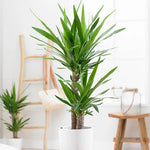
Yuccas
$64.00 USD
Unit price perEstimated delivery between December 31 and January 02.
Yucca is a genus of over 40 perennial plants, shrubs, and trees. A few are grown as houseplants, including Yucca gigantea (also known as Y. guatemalensis and Y. elephantipes) and the Yucca aloifolia.
Some are fast-growing, growing up to 2 feet per year, while others grow slowly, about 5 inches a year. All are extremely drought tolerant. Most can grow outdoors, withstanding cold snaps down to 10°F. Some varieties can survive subzero temperatures. Pet owners should take caution if adding yucca plants—all parts of the plant are toxic to dogs and cats (as well as horses).
Growing Outdoor Yucca Plants
Yucca plants are hardy and can tolerate harsh conditions: poor, sandy, well-drained soil and full sun, even drought and salt spray. These tough plants should be kept away from paths and sidewalks as their leaf tips grow sharp and could injure passersby. Also, their roots can disrupt sidewalks.
Outdoor plants have a higher chance of blooming regularly than their indoor counterparts. Plant outdoors in the sun, where it can receive just a few hours of shade during the day.
In order to relocate an indoor yucca outside, acclimate the plant by hardening it off several hours each day outside. This slow integration will reduce chances of leaf burn or systemic shock.
If your yucca species isn't cold hardy, it should be brought back inside as the weather turns cold. In the same way, hard off the plant so it becomes accustomed to indoor life.
Indoor Yucca Plant Care
Under the right conditions, yucca plants are not difficult to grow. In the right conditions, they live about five years as houseplants and up to 20 to 50 years if grown outdoors.
A bright corner with relatively low humidity is the best indoor condition for a yucca plant. Additionally, yucca plants are not prone to many pests, although scale insects can occasionally be an issue.2
Over time, yucca plants will typically lose their lower leaves (in nature, they droop, forming a skirt around the trunk), giving the plant a pleasant "tree-like" appearance.
Light
Yucca plants thrive in bright, indirect light indoors. Growing yucca in too little light can result in thinner and slower growth, while intense, direct sunlight can cause white spots on leaves or crispy, brown tips.
Soil
Yucca plants naturally grow in sandy terrain. Inside, plant your yucca in a loose, well-drained potting mix. Low-maintenance yuccas do not need specially formulated or rich fancy soil. Instead, get an inexpensive potting mix and blend in coarse sand and perlite to promote drainage.
Water
Yuccas are highly sensitive to overwatering. Water your plant once a week during the spring and summer growing seasons, but ensure it has excellent drainage and dries out between waterings. Come winter, decrease your watering cadence to once every few weeks (or even less). Never let a yucca plant sit in a tray of water.
Temperature and Humidity
Yucca plants are adapted to the desert, where temperatures can soar above 90°F during the day and down to 30°F at night. Therefore, yuccas are relatively adaptable to most indoor temperature conditions and fluctuations. They will grow best with moderate humidity, but as desert plants, they are perfectly content in dry conditions, and there is never any need to mist this plant.
Fertilizer
Fertilize your indoor yucca plant during the growing season with liquid or controlled-release fertilizer according to label instructions. A once-a-month feeding is usually sufficient.
All sales of live plants are final; returns are not accepted.
Share
FEADTURED COLLECTIONS
Enhance your home with our collection of indoor plants, designed to purify the air and add a touch of natural beauty to any room. Easy to care for and perfect for any space.
Discover the elegance and beauty of our 'Orchids & Flowers' collection, featuring a curated selection of vibrant blooms that add a touch of nature's finest artistry to any space. From the exotic allure of orchids to the timeless charm of classic flowers, each plant is carefully chosen for its unique beauty and ability to bring life and color into your home. Perfect for plant lovers and decorators alike, this collection offers a range of options to suit every style and occasion.
Myrtle Topiary
From $28.00 USD
Unit price perBegonia Red Fred
From $45.00 USD
Unit price perMarantha Prayer Plant
From $18.00 USD
Unit price per



































